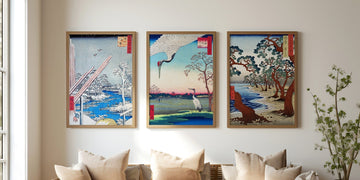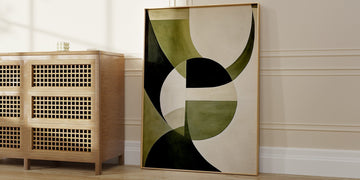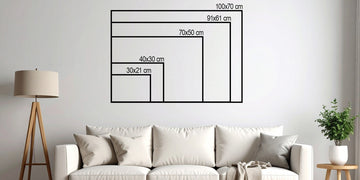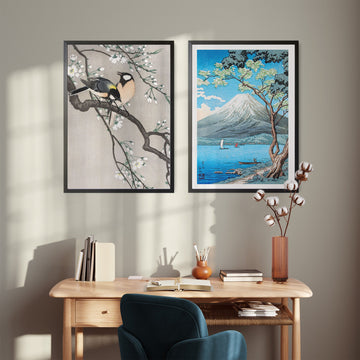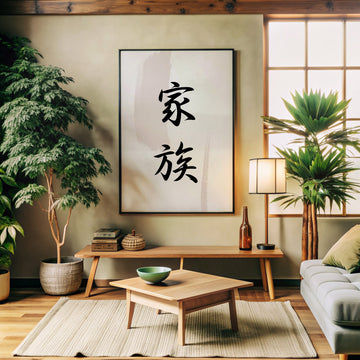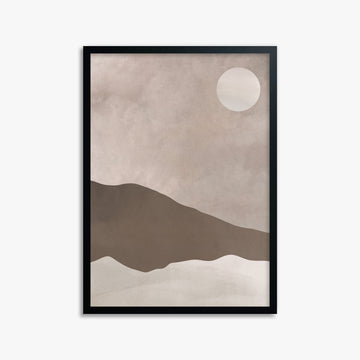Ever wondered why some of the most iconic Japanese artworks come in series? You know the ones - Hokusai's multiple views of Mount Fuji, Hiroshige's endless scenes of the same locations, each slightly different but somehow perfectly capturing something new. It turns out this isn't just artistic repetition for the sake of it. There's a whole philosophy behind why Japanese artists chose to paint the same subject dozens of times, and honestly, it's pretty genius.
If you've ever found yourself scrolling through someone's Instagram feed of the same coffee shop from different angles (we've all been there), you're actually participating in a tradition that goes back centuries. The Japanese mastered the art of finding infinite beauty in finite subjects long before we had smartphones and social media.
What's the Deal with Japanese Serial Art?
Picture this: instead of creating one "perfect" painting of Mount Fuji, Hokusai decided to paint it 46 different ways. From different seasons, weather conditions, times of day, and perspectives. Each view revealed something new about Japan's most famous mountain, but also something new about the way we see the world.
The most famous Japanese art series include
Hokusai's "Thirty-six Views of Mount Fuji" (actually 46 prints) - The OG of serial art
Poster: The Great Wave off Kanagawa by Katsushika Hokusai - Part of Hokusai's "Thirty-six Views of Mount Fuji" series and perhaps the most iconic artwork in classical Japanese painting
Hiroshige's "One Hundred Famous Views of Edo" - Tokyo before it was Tokyo
Poster: Minowa, Kanasugi at Mikawashima by Utagawa Hiroshige - Part of the serie "Fifty-three Stations of the Tōkaidō"
Hiroshige's "Fifty-three Stations of the Tōkaidō" - The ultimate travel guide meets art project
This wasn't just artists being indecisive about which version to choose. During Japan's Edo period (1603-1868), creating art series was both a smart business move and a profound artistic statement.
Why Did Japanese Artists Fall in Love with Repetition?
Printing made art accessible to everyone Before mass printing, art was mainly for the wealthy. Woodblock printing changed the game, making individual prints affordable for the growing middle class. Instead of dropping serious cash on one painting, people could gradually collect an entire series. Think of it as the original subscription model - but for art.
Travel was having a moment The Edo period was basically Japan's golden age of domestic tourism. New roads, peaceful times, and a culture that celebrated pilgrimage and travel meant people were obsessed with famous places. Art series became visual travel guides, feeding people's wanderlust and helping them explore places they might never visit.
It reflected a different way of seeing Unlike Western art traditions that often sought the single "perfect" view, Japanese artists believed that no one perspective could capture the whole truth. A farmer's view of Mount Fuji was just as valid as a noble's view. This democratic approach to perspective was pretty revolutionary for its time.
The Deep Philosophy Behind Serial Art
Japanese serial art isn't just about creating multiple versions - it's rooted in profound philosophical concepts that shaped how artists and viewers understood the world.
Ma (間) - The Power of Space Between This concept is about negative space and intervals, but in serial art, it's the space between images that creates meaning. Each print gains significance through its relationship to the others, creating a rhythm that flows across the entire series.
Mono no Aware (物の哀れ) - The Beauty of Impermanence Often translated as "the bittersweet awareness of the impermanence of all things," this aesthetic principle drove artists to capture the same subject across different seasons and conditions. Mount Fuji stays the same, but everything around it - weather, light, human activity - constantly changes. It's a gentle reminder that nothing lasts forever, and that's what makes it beautiful.
Poster: The Jewel River in Musashi Province by Katsushika Hokusai
Buddhist Influence on Multiple Perspectives Buddhism teaches that no single viewpoint can capture ultimate truth. This philosophy encouraged artists to explore subjects from numerous angles, both literally and metaphorically. Each new view was another step toward understanding something deeper.
What These Art Series Mean for Human Experience
Meditation through repetition Creating multiple views of the same subject becomes a form of meditation. Hokusai was in his seventies when he created his Mount Fuji series, and he famously said that everything he painted before age seventy "wasn't worth counting." Each new perspective represented deeper understanding and refined perception.
Everyone's perspective matters These series suggested that beauty could be found from any vantage point. Whether you were rich or poor, your view of the world had value. This was pretty progressive thinking for any era.
Creating mental maps For viewers, these series helped them understand and navigate their world. Hiroshige's views of Edo helped people construct mental maps of their city, creating shared cultural references that everyone could relate to.
How Artists Made Each View Special
Playing with perspective
-
Spatial variations - Close-up details vs. distant views
-
Temporal changes - Different seasons, times of day, weather
-
Compositional shifts - Varying foreground elements while keeping the main subject
Color as emotional language: Hokusai's famous "Red Fuji" and "Black Fuji" show how the same mountain could convey completely different moods through color alone. Red Fuji feels triumphant and energetic, while the darker versions evoke mystery and contemplation.
Poster: Fine Wind, Clear Morning by Katsushika Hokusai of the serie "Fifty-three Stations of the Tōkaidō"
Everyday life in the frame: Many series incorporated human activities - farmers working, travelers resting, festivals happening. This showed how the landscape served as a backdrop for real life, mixing the permanent with the everyday.
Why This Ancient Art Form Still Matters Today
We're all creating series now Think about it - Instagram stories, TikTok trends, photo dumps of the same location. We're all unconsciously following this Japanese tradition of serial documentation. The difference is intent and mindfulness.
Mental health benefits Modern psychology backs up what Japanese artists knew centuries ago: repetitive observation and creation can be meditative and reduce anxiety. There's something deeply calming about returning to the same subject with fresh eyes.
Environmental awareness In our climate-conscious era, the careful attention these artists paid to seasonal changes and natural phenomena provides valuable historical records. They also encourage us to slow down and really observe our environment.
Photography and contemporary art Modern photographers like Hiroshi Sugimoto continue this tradition with series like "Seascapes" - hundreds of photos of horizons that are similar yet unique. Contemporary artists worldwide have adopted serial approaches to explore themes of repetition and variation.
What We Can Learn from Japanese Serial Art
In our fast-paced, instant-gratification culture, Japanese serial art teaches us some valuable lessons:
Slow looking has value Instead of quickly scrolling past, these series reward patient observation. Each viewing reveals new details and meanings.

There's no single "right" way to see something Just as Hokusai found 46 different ways to view Mount Fuji, there are multiple valid perspectives on everything in life. This can be incredibly freeing and inclusive.
Repetition isn't boring - it's revelatory What seems like the same thing repeated can actually reveal infinite variations and deeper truths. Whether it's your daily commute, your morning coffee, or your view from your window, there's always something new to discover.
Beauty exists everywhere You don't need exotic locations or perfect conditions to create something meaningful. Some of Hokusai's most famous Mount Fuji views include it as a small element in everyday scenes.
Bringing Serial Art Into Your Space
When you're choosing wall art for your home, consider the Japanese approach to serial viewing:
Create your own series Instead of random, unrelated pieces, consider building a cohesive collection around a theme - botanical studies, architectural details, or abstract patterns that work together.
Think about the conversation between pieces How do your chosen artworks speak to each other? What story do they tell when viewed together?
Embrace repetition with variation Multiple pieces with similar subjects but different treatments can create visual harmony while maintaining interest.
Consider the rhythm of your walls Like the concept of "ma," think about the spaces between your artwork and how they create flow throughout your home.
The Timeless Appeal of Looking Again
Japanese serial art reminds us that to truly see something, we must be willing to look again and again. Whether you're viewing Hokusai's Mount Fuji through spring cherry blossoms or winter snow, or following Hiroshige's journey along historic roads, you're participating in a meditation on perception itself.
In a world that often pushes us to move fast and consume quickly, these artists teach us that repetition isn't redundant - it's a path to deeper understanding. Each time we return to look at something familiar, we bring new experiences, emotions, and perspectives that reveal previously hidden meanings.
The next time you see the same view from your window, or walk the same route to work, or even scroll past similar images online, remember the Japanese masters who found infinite beauty in finite subjects. They knew something we're still learning: that the art isn't just in seeing, but in seeing again, and again, with fresh eyes and an open heart.
Ready to create your own thoughtful series? Explore our collection of Japanese-inspired prints that work beautifully together, helping you build a cohesive, calming wall display that rewards repeated viewing.

